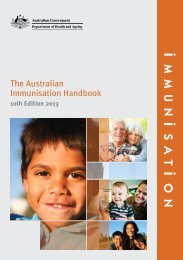English - pdf - 1234 Kb - Malaysian Paediatric Association
English - pdf - 1234 Kb - Malaysian Paediatric Association
English - pdf - 1234 Kb - Malaysian Paediatric Association
Create successful ePaper yourself
Turn your PDF publications into a flip-book with our unique Google optimized e-Paper software.
20<br />
How to Make A Splint<br />
A splint is a first aid, short-term treatment for an injured body part. The purpose of<br />
a splint is to protect a wounded body part from further damage until you get<br />
medical help. It is important to check for good circulation after the injured body<br />
part has been immobilized.<br />
Here is how you can make a splint.<br />
1. First, find something that is rigid,<br />
such as a piece of wood, a stick, or<br />
rolled up newspaper.<br />
2. Place the object against the injured<br />
body part.<br />
3. Wrap tape around the object and<br />
the body part to hold them<br />
together.<br />
4. Attempt to splint injuries in the<br />
position in which they are found.<br />
Do not try to straighten or realign<br />
the injured body part.<br />
5. Extend the splint beyond the<br />
injured area. Try to prevent<br />
movement of the joints above and<br />
the joints below the injured area, if<br />
you can. Sometimes this will be<br />
impossible because of the location<br />
of the injury<br />
6. Once the splint has been secured,<br />
use devices such as belts or cloth<br />
strips to tie in place. To avoid<br />
stopping blood flow, do not make<br />
knots and ties too tight.<br />
7. Check often after the splint is in<br />
place to make sure that the blood<br />
flow is not cut off.<br />
8. Seek medical attention.<br />
Cardiopulmonary<br />
Resuscitation (CPR)<br />
CPR can save a child’s life if his heart<br />
stops beating or he has stopped<br />
breathing for any reason – drowning,<br />
poisoning, suffocation, choking. It is<br />
most successful if given immediately<br />
after the heart or breathing stops.<br />
Danger signs that may alert you that CPR<br />
might be needed:<br />
• Unresponsiveness, with no evidence<br />
of effective breathing<br />
• Extreme difficulty in breathing<br />
• Blue lips or skin<br />
• Severe wheezing<br />
• Drooling, or difficulty in swallowing<br />
with trouble breathing<br />
• Extreme paleness
















